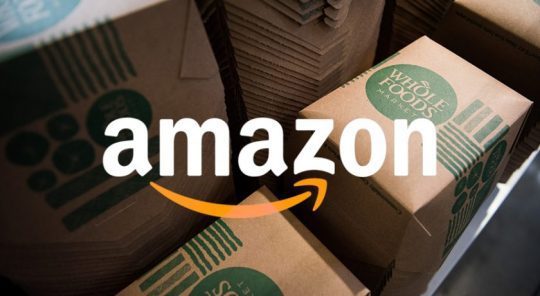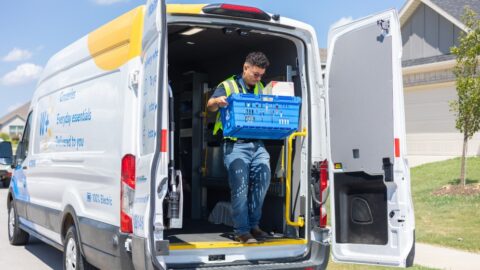 Even for a company that routinely generates big headlines, Amazon made quite a splash with its purchase of Whole Foods in June. The retailer got even more attention when it lowered prices on key items at the grocer-formerly-known-as-“Whole-Paycheck” in late August. But Amazon is after more than just a public relations spike, or even the 25% customer traffic increase that it generated, according to Bloomberg.
Even for a company that routinely generates big headlines, Amazon made quite a splash with its purchase of Whole Foods in June. The retailer got even more attention when it lowered prices on key items at the grocer-formerly-known-as-“Whole-Paycheck” in late August. But Amazon is after more than just a public relations spike, or even the 25% customer traffic increase that it generated, according to Bloomberg.
What Amazon got from buying Whole Foods was a real-world testing lab for its pricing strategies. This strategy could be a boon for competing retailers, which have traditionally had difficulty tracking the multiple price changes Amazon is capable of making online. Moving its price changes into the open air of a supermarket, where they are by nature quite visible, could give competitors a clearer view of the e-Tail giant’s tactics.
Competitors also might take some comfort from the fact that Amazon’s actions acknowledge the continuing relevance of brick-and-mortar retailing, but in reality, their feelings of worry may far outweigh their feelings of satisfaction.
Advertisement
Whole Foods: A 456-Unit Testing Lab
Industry experts have been quick to call out Amazon for its experiments with Whole Foods. In a recent Harvard Business Review article, Hermann Simon, founder and chairman of Simon-Kucher & Partners, noted:
“Last month, [Amazon] bought a network of 456 customer-friendly testing facilities which welcome roughly eight million ‘volunteers’ each week. Amazon’s relentless price testing in the online world anchors its competitive advantage. Its unrivaled base of knowledge allows it to use price as a communications tool, a recruiting tool, a psychological weapon, and a value driver in ways that transcend the basic mechanics of supply and demand and profit and loss. Now Amazon can supplement that knowledge with direct, proprietary insights about the offline retail world.”
Simon added that he sees Amazon’s price strategy, “fueled by constant testing and experimentation,” as evolving in three steps:
- Changing price perception;
- Growing the market for healthy foods; and
- Applying insights to other offline retail sectors and services.
He noted that Amazon announced its price changes in stores with large, eye-catching posters showing the former (higher) price, the new (lower) price and a message reading “more to come” at the bottom. Including both prices, rather than showing a percentage decrease figure, reinforced the fact that the changes had crossed the psychologically important “whole dollar” thresholds, e.g. avocados went from $2.50 to $1.99.
Alibaba Has A Head Start In Price Testing
Alibaba, the Amazon of China (or is Amazon the Alibaba of America?) also has expanded its brick-and-mortar presence, with the announcement that construction of a five-story mall near its headquarters in Hangzhou, China was well under way (completion is slated for April 2018). What caught my eye in this story was that the mall would contain a Hema supermarket.
There are only 18 Hema stores, a fraction of the number of Whole Foods locations, but Alibaba can make up for the lack of scale with the depth of data it’s able to gather from consumers. Hema was essentially designed around the mobile experience: the Hema supermarket app connects customers to Alibaba’s e-Commerce platform, allowing them to shop for groceries online, for delivery or pickup. Customers can pay for their purchases using Alipay, Alibaba’s online payment platform.
“Alibaba also sees itself as a data company, having captured a significant amount of user data with more than half a billion people shopping on its platform that buy something at least once a month,” wrote Brian Deagon in a recent Investor’s Business Daily article titled “Alibaba Expands Into Groceries To Corral The Digital Consumer.” The article noted that at the end of June 2017, Alibaba reported that it had 466 million annual active customers and 529 million people visiting Alibaba sites via mobile devices.
So it’s highly likely that Alibaba is already years ahead of Amazon when it comes to understanding the impact of pricing on consumers, not to mention their product preferences, delivery vs. pickup patterns, grocery products vs. fresh prepared foods, etc. Whether such data is unique to the China marketplace is irrelevant; the point is that Alibaba has the tools and templates in place for such data gathering when it does expand into new markets.
It’s logical that both Amazon and Alibaba have chosen grocery stores as their testing “labs,” even though they have built-in disadvantages — including the challenges of handling fresh items, razor-thin profit margins and a group of well-entrenched competitors. Since everybody eats, supermarkets provide both brands with a constant supply of hungry test subjects.















